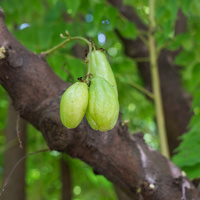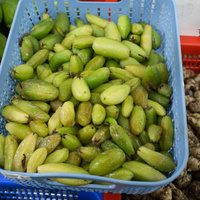Common name: Bilimbi
Other common names: Bimbling plum, Cucumber tree, Long jimbelin, Tree sorrel
Description
Bilimbi is a fruiting tree originating from humid forests in Malaysia and Indonesia. Over time, its range has spread to neighbouring Singapore, Thailand, Myanmar (Burma), Sri Lanka, India and the Philippines. It is also now common where populations of Indians and Sri Lankans have migrated and settled, such as Fiji, parts of Africa and the Caribbean.
The tree may reach heights of up to 18 m (60 ft), though is more commonly 5 to 10 m (16 to 32 feet) tall with a short trunk and wide-spreading branches forming a rounded crown. The bark is brownish-pink and smooth on young trees, becoming grey and flaking on older trees.
The leaves are large, 30 to 60 cm (12 to 24 in) long and feather-like, being made up of up to thirty-five oblong-pointed, medium-green leaflets, arranged in pairs opposite along the length and with an extra leaflet at the tip. They are evergreen, and so remain on the tree in all seasons.
The flowers are five-petaled, crimson-red, 2.5 cm (1 in) long and almost as wide, held in long clusters borne directly on the trunk and branches. They bloom year-round but tend to be more abundant in the dry season and are followed by unusual cucumber-shaped fruit that are made even more curious by their hanging in clusters from the trunk.
The fruit are 2 to 9 cm (2 to 3.5 in) long, firm, faintly ribbed and with thin, smooth glossy green skin, becoming pale yellow and soft when ripe. The pulp is juicy, crisp when unripe, jelly-like when ripe and with either no seed or a few flat, pale seed.
Use
The fruit pulp is high in ascorbic acid, which makes it very sour and is therefore not usually eaten fresh, though there are reports of an uncommon variety with only moderately sour pulp.
Bilimbi fruit are usually either dried, candied, preserved in syrup or made into jelly, relishes or pickles, and make an excellent substitute for green mango in chutneys. They also yield a juice used as a souring agent in cooking and to flavour cold drinks or beverages. The acid pulp is also used as a natural stain remover on clothes and to polish brass and silver.
Health use
The leaves are made into a paste or poultice used against skin inflammations, including itchy skin and skin eruptions generally. A cough syrup is made from the fruit.
Climate
Grows naturally in moderately humid to humid subtropical and tropical lowland climates, generally in frost-free areas with annual lows of 17 to 25°C, annual highs of 26 to 35°C, annual rainfall of 1400 to 4500 mm and a dry season of 5 months or less.
Growing
New plants can be raised from seed, but are mostly propagated from cuttings and using air-layering (circumposing) techniques because seed-grown trees do not always inherit the characteristics of the parent.
Performs best on rich, free-draining loam and sand soils of a moderately acid to slightly alkaline nature, generally with a pH of 5.5 to 7.5 and on sites with full to partial sun exposure. It has good tolerance to limestone soils, but poor tolerance to shade conditions.
Problem features
It is listed as a weed in at least one reference publication, however, there does not appear to be any record of it anywhere as a serious weed. It is assessed as a low weed risk species for Hawaii, by the Hawaii Pacific Weed Risk Assessment project (HPWRA).
This fruit have a high oxalic acid content which may adversely affect kidney function in some and the ascorbic acid in the pulp can cause gastric irritation if ingested in large quantities.
Where it grows
References
Books
-
Adams, C. D. 1972, Flowering plants of Jamaica, University of the West Indies, Mona, Greater Kingston
-
Allen, B. M. 1967, Malayan fruits : an introduction to the cultivated species, Donald Moore Press, Singapore
-
Janick, J., & Paull, R. E. 2008, The encyclopedia of fruit & nuts, CABI Publishing, Wallingford, Oxfordshire
-
Jensen, M. 1999, Trees commonly cultivated in Southeast Asia : an illustrated field guide, 2nd ed., Food and Agricultural Organisation of the United Nations (FAO) Regional Office for Asia and the Pacific (RAP), Bangkok
-
Kennard, W. C. & Winters, H. F. 1960, Some fruits and nuts for the tropics, Miscellaneous Publication No. 801, U.S. Department of Agriculture, Federal Experimental Station, Mayaguez, Puerto Rico
-
Macmillan, H. F. 1943, Tropical planting and gardening : with special reference to Ceylon, 5th ed, Macmillan Publishing, London
-
Martin, F. M., et al. 1987, Perennial edible fruits of the tropics : an inventory, U.S. Dept. of Agriculture (USDA), Agricultural Research Service, U.S. Government Printing Office (GPO), Washington, D.C.
-
Morton, J. F. & Dowling, C. F. 1987, Fruits of warm climates, Creative Resources Systems, Winterville, North Carolina
-
Randall, R. P. 2002, A global compendium of weeds, R.G. and F.J. Richardson Press, Melbourne
-
Randall, R. P. 2007, The introduced flora of Australia and its weed status, Cooperative Research Centre for Australian Weed Management, Glen Osmond, South Australia
-
Seidemann, J. 2005, World spice plants: economic usage botany taxonomy, Springer-Verlag, Berlin
-
Selvam, V. 2007, Trees and shrubs of the Maldives, Food and Agriculture Organisation (FAO) RAP publication (Maldives), Thammada Press Company Ltd., Bangkok
Articles, Journals, Reports and Working Papers
-
Subhadrabandhu, S. 2001, Under-utilized tropical fruits of Thailand, Food and Agriculture Organisation of the United Nations (FAO), Regional Office for Asia and the Pacific (RAPA), Bangkok
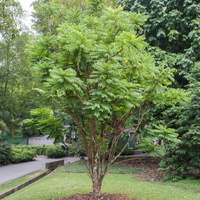
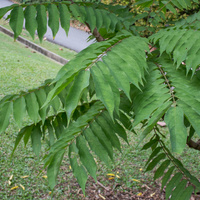
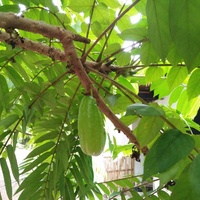
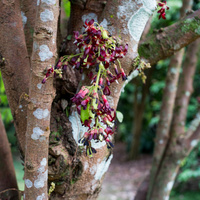
.5876.thumb.jpg)
.5801.thumb.jpg)
